GDPR Email Marketing
How GDPR Reshaped Email Marketing Tactics: 3 Key Changes
Faced with the GDPR, email marketing tactics have undergone significant changes, transforming the way we engage with subscribers and protect their data.
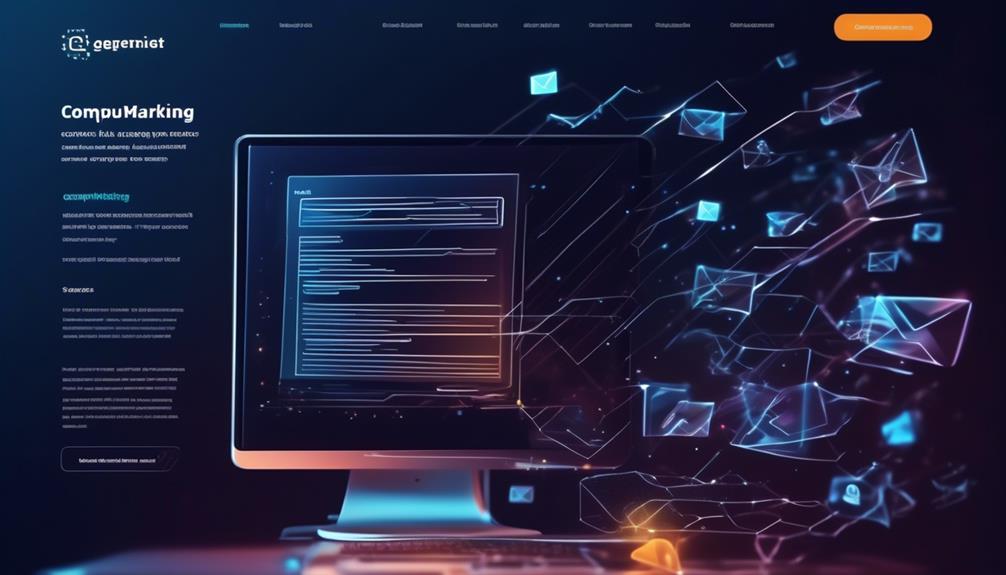
Remember when email marketing was essentially about sending mass emails and keeping fingers crossed for a positive outcome?
Well, the GDPR has completely shaken things up, and we've had to adapt in some pretty significant ways.
From rethinking how we obtain consent to beefing up our data security measures, the changes have been substantial.
But what exactly are the three key shifts that have taken place, and how have they reshaped the way we approach email marketing?
Let's just say, it's been quite the journey, and the destination is definitely worth exploring.
Key Takeaways
- Obtaining explicit and informed consent is crucial for conducting email marketing activities under GDPR.
- Companies must prioritize data storage and protection, ensuring that personal data is securely stored and only retained when necessary.
- GDPR has necessitated a shift in how companies handle personal data for targeting and segmentation in email marketing, requiring a legal basis and clear information for data collection and usage.
- Compliance with GDPR, including the appointment of a Data Protection Officer, demonstrates a commitment to privacy and data security, fostering trust with customers.
Impact on Email Consent
Obtaining explicit and informed consent is a pivotal requirement for conducting email marketing activities under the General Data Protection Regulation (GDPR). This necessitates clear and specific actions to ensure compliance with the stringent consent standards.
GDPR has significantly impacted email marketing by placing a strong emphasis on obtaining explicit consent from individuals before processing their personal data for marketing purposes. This means that companies must ensure that the consent obtained is freely given, specific, informed, and unambiguous.
The information provided to individuals must be clear and transparent, detailing how their data will be used, stored, and shared. Additionally, GDPR prohibits the use of pre-ticked opt-in boxes or default options for consent. This requires individuals to take affirmative action to opt into receiving marketing communications.
As a result of GDPR, companies have had to reevaluate their email marketing practices to align with the new consent requirements. This includes reviewing and updating their consent mechanisms to ensure they meet the standards set forth by the regulation.
Furthermore, companies need to be mindful of data subject rights, including the right to withdraw consent at any time. Overall, the impact of GDPR on email consent has compelled organizations to prioritize data privacy and security while conducting email marketing activities.
Data Storage and Protection

Under the General Data Protection Regulation (GDPR), companies are required to diligently safeguard and securely store customers' personal data, implementing stringent measures to prevent unauthorized access or misuse. Compliance with GDPR necessitates that businesses only retain necessary personal data and delete it when it's no longer required. This regulation also mandates the appointment of a Data Protection Officer (DPO) to ensure and oversee compliance.
In the context of email marketing, GDPR's impact on data storage and protection is significant. Marketers must ensure that the personal data collected for email marketing purposes is stored securely and used in a manner consistent with the regulation. Moreover, in the event of a data breach, GDPR requires that companies report the breach to the relevant authorities within 72 hours. This emphasizes the critical importance of implementing robust security measures to safeguard customer data.
Adhering to GDPR's data storage and protection requirements not only ensures compliance but also demonstrates a commitment to privacy and data security, ultimately fostering trust with customers.
Changes in Targeting and Segmentation
In light of the General Data Protection Regulation (GDPR), our approach to targeting and segmentation has undergone significant changes, necessitating a meticulous review of how we collect, store, and utilize personal data for these purposes.
The GDPR has necessitated a shift in how companies handle personal data for targeting and segmentation in email marketing. Companies are now required to have a legal basis, such as explicit consent, for processing personal data for these purposes. Moreover, they must ensure that they only collect necessary data and use it for compatible purposes. Additionally, clear and concise information about data collection and usage must be provided to customers, ensuring transparency and accountability in segmentation and targeting practices.
As a result, email marketing tactics have evolved to prioritize consent-based targeting and segmentation, ensuring that the processing of personal data complies with GDPR regulations. This shift not only aligns with the GDPR's requirements but also demonstrates our commitment to respecting the privacy and data protection rights of EU citizens.
As we navigate these changes, our Data Protection Officer plays a crucial role in overseeing and ensuring compliance with GDPR regulations in our targeting and segmentation practices. Furthermore, including an easily accessible unsubscribe link in our emails further emphasizes our commitment to respecting individuals' rights and preferences regarding their personal data.
Frequently Asked Questions
What Has GDPR Resulted in for Email Marketing?
GDPR has resulted in stricter rules for obtaining consent for email marketing, requiring explicit and informed consent from subscribers. Companies are now required to implement enhanced data storage and protection measures to ensure the security of customers' personal data.
The GDPR has led to significant changes in how companies approach segmentation and targeting for email marketing, emphasizing the need for a legal basis and transparent data usage.
Email marketing tactics under GDPR now require clear opt-in and opt-out mechanisms, prohibiting pre-ticked boxes and default options for consent.
What Are the Key Changes of Gdpr?
We acknowledge the key changes brought about by GDPR, including stricter consent requirements, revised rules for data handling, and the mandatory appointment of a Data Protection Officer.
We've adapted our email marketing tactics to ensure compliance with these changes, prioritizing explicit, informed, and freely given consent.
We've also adjusted our data collection, storage, and usage practices to align with GDPR's guidelines, emphasizing responsible and compliant segmentation and targeting.
What Are the Three Main Goals of the Gdpr?
The three main goals of the GDPR are:
- To give EU citizens more control over their personal data.
- This reflects a commitment to data privacy and security.
- It ensures that individuals have a say in how their information is used.
- To require companies to obtain explicit consent before sending promotional emails.
- This goal aims to protect individuals from unsolicited and unwanted marketing messages.
- It empowers individuals to choose which communications they receive.
- To mandate the protection and secure storage of customer data.
- This goal ensures that companies handle customer data responsibly and protect it from breaches or unauthorized access.
- It holds companies accountable for the secure handling of personal information.
These three goals work together to enhance data privacy, empower individuals, and promote responsible data handling by companies.
How Does GDPR Affect Emails?
GDPR significantly impacts email marketing by requiring explicit consent for sending promotional emails and newsletters. Companies must prioritize data protection and secure storage, utilizing opt-ins and opt-outs to ensure compliance.
GDPR has transformed how personal data is collected, stored, and used for segmentation and targeting. To adhere to GDPR, businesses need to conduct privacy impact assessments, strengthen consent mechanisms, and ensure transparency in their email marketing practices.
What are the key changes that GDPR has brought to email marketing tactics?
The reasons for GDPR impact on email marketing tactics are numerous. Marketers now need explicit consent to send promotional emails, and individuals have more control over their personal data. This has led to a shift towards permission-based marketing and greater emphasis on data protection and privacy compliance.
Conclusion
In conclusion, the GDPR has truly transformed email marketing tactics, like a gust of wind reshaping a landscape.
With stricter consent requirements, enhanced data protection measures, and changes in targeting and segmentation, businesses must adapt to prioritize customer consent and data security.
It's an evolving landscape, but by embracing these changes, companies can build trust with their customers and ensure compliance with the new regulations.
Natali – Editor in Chief (Strategy and Mastery, AI Expert) Natali, our Editor in Chief, is the driving force behind our content’s strategic direction. With a keen eye for detail and a deep understanding of market trends, Natali ensures that our content is top-notch and strategically aligned with our client’s goals. Her expertise in AI helps to seamlessly integrate advanced technology into our marketing strategies, pushing the boundaries of conventional marketing.
GDPR Email Marketing
7 Best GDPR Compliance Tips for Email Marketers
Tread carefully through the complexities of GDPR compliance with these seven essential tips for email marketers, ensuring your campaigns are legally sound and effective.

As email marketing professionals, we navigate the delicate balance of engaging our audience while protecting their privacy. In the current digital environment, with tightening data protection laws, it’s essential to find a middle ground that respects our subscribers’ rights while effectively reaching out to them.
As we navigate the complexities of GDPR compliance, there are seven key tips that can significantly impact our email marketing strategies and ensure that we stay on the right side of the law. These tips not only address the legal requirements but also contribute to more targeted and effective campaigns, reduced risk of fines and penalties, improved data security and privacy practices, and a strengthened brand reputation.
Key Takeaways
- Explicit consent is mandatory for processing personal data for email marketing under GDPR.
- Implement robust consent management systems to track and record consent.
- Regularly review and update consent agreements.
- Maintain comprehensive and secure records of consent.
Consent Requirements
Ensuring compliance with GDPR consent requirements for email marketing is crucial for maintaining data privacy and avoiding legal issues. Under the GDPR, obtaining explicit consent is mandatory for processing personal data for email marketing. This means that individuals must freely, specifically, and unambiguously consent to their data being used for marketing purposes.
To manage consent effectively, email marketers should implement robust consent management systems to track and record consent from subscribers. Additionally, the opt-in method should be used, and proof of consent must be retained to demonstrate compliance. Legacy contacts also require repermissioning to ensure that their consent meets GDPR standards.
Every marketing communication should include a clear and easy-to-access unsubscribe link, allowing individuals to opt-out at any time. It's essential to regularly remind subscribers of their right to withdraw consent and provide them with easy mechanisms to do so.
Data Minimization Practices
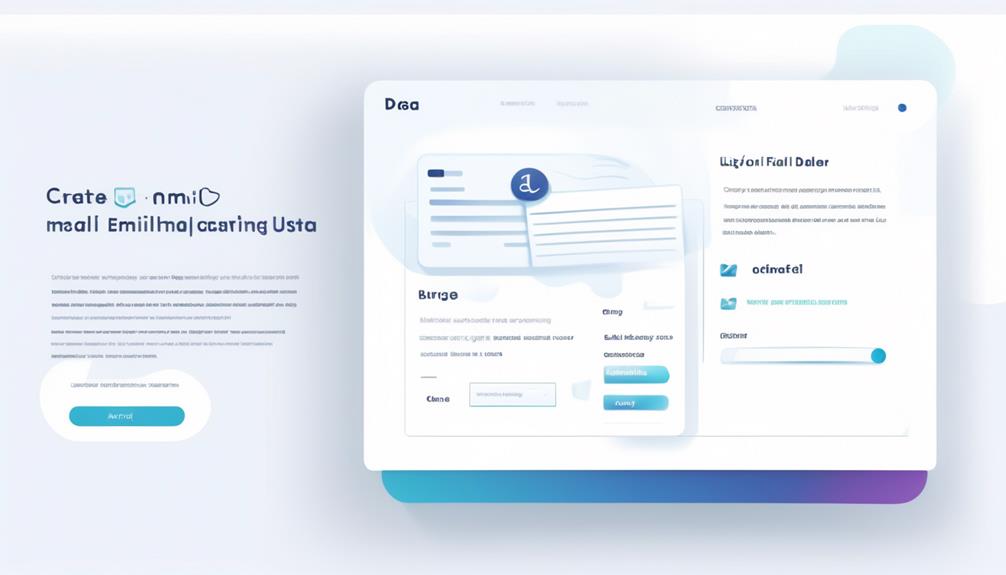
As email marketers, we must prioritize limiting the data we collect, securing the storage of that data, and regularly reviewing the information we have.
By only gathering the necessary personal data and regularly reassessing what we store, we can reduce the risk of privacy violations and data breaches.
Implementing clear processes for data deletion and obtaining explicit consent for each purpose will further ensure GDPR compliance.
Limit Data Collection
To comply with data minimization practices, email marketers should collect and retain only the necessary data for email marketing purposes and ensure clear and specific consent processes for data collection. This approach aligns with GDPR requirements and demonstrates a commitment to privacy and data protection. When limiting data collection, consider the following:
- Clear Communication: Inform individuals about the purpose and duration of data collection for email marketing, ensuring transparency and compliance with privacy regulations.
- Regular Consent Review: Review and update consent agreements regularly to adhere to data minimization principles and maintain compliance with GDPR.
- Accessible Withdrawal Options: Provide individuals with accessible options to withdraw their consent for email marketing data collection, respecting their right to privacy.
- Security Measures: Implement robust security measures to safeguard the processed personal data, maintaining its confidentiality and integrity.
Secure Data Storage
When it comes to email marketing, securely storing only the essential personal data is crucial to align with data minimization practices and maintain GDPR compliance. It's vital to evaluate and minimize the amount of personal data collected and stored, ensuring it aligns with the GDPR's data minimization principle. Regularly reviewing and updating data storage practices is essential to ensure compliance with GDPR requirements. Employing pseudonymization and encryption techniques can reduce the amount of personally identifiable information stored, in line with GDPR's data minimization principles. Here's a table highlighting key points for secure data storage in email marketing:
| Key Points | Description |
|---|---|
| Minimize Data Collection | Evaluate and minimize the amount of personal data collected and stored. |
| Pseudonymization | Consider employing pseudonymization techniques to reduce personally identifiable information. |
| Encryption Techniques | Use encryption to secure stored personal data in compliance with GDPR. |
Implementing these practices ensures secure data storage, aligns with GDPR requirements, and protects personal data privacy.
Regular Data Review
Regularly reviewing and minimizing the personal data collected is essential to ensure compliance with data minimization practices under GDPR. When it comes to email marketing, data review is crucial for maintaining GDPR compliance and respecting privacy rights of EU citizens.
Here's how to effectively implement data minimization practices:
- Conduct periodic audits to ensure only necessary personal data is collected and processed.
- Implement processes to clean and update mailing lists regularly, removing unnecessary or outdated personal data.
- Document and maintain records of specific purposes for using personal data in email marketing.
- Establish clear consent mechanisms for individuals to opt-out and manage their data in line with GDPR's data minimization principles.
Obtaining Explicit Consent
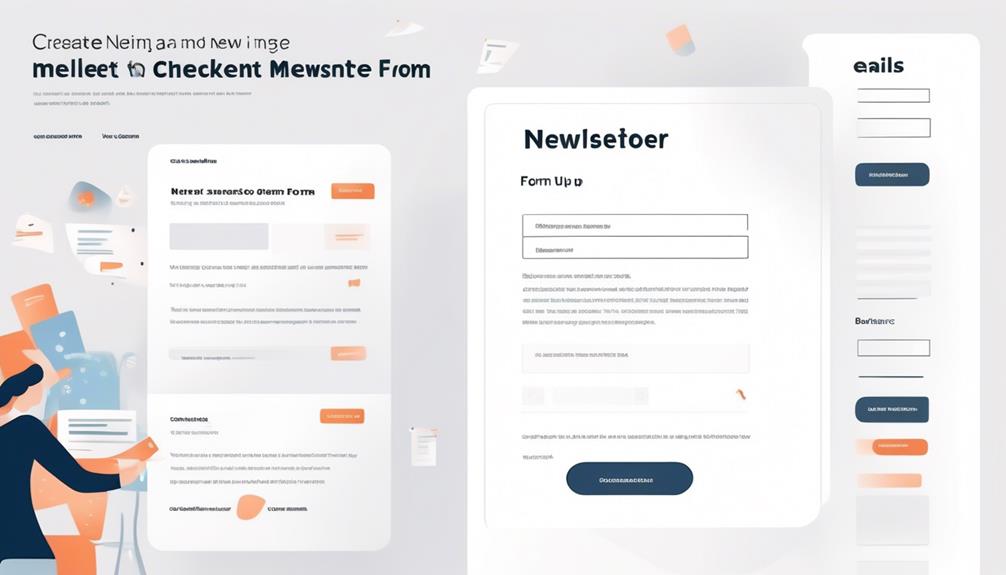
We clearly communicate the purpose of data collection and obtain explicit consent for email marketing to ensure GDPR compliance. Obtaining explicit consent from subscribers is crucial, as individuals have the right to confirm their consent before receiving marketing emails. To achieve this, we implement a double opt-in process, where individuals actively confirm their consent. This ensures that the consent obtained is valid and unambiguous. Additionally, we separate consent requests from terms and conditions, making the consent specific, informed, and clear. This practice not only aligns with GDPR compliance but also builds trust with subscribers. Moreover, providing easy opt-out options in every marketing communication and promptly honoring withdrawal of consent is essential. To maintain GDPR compliance in email marketing, we regularly review and update consent agreements. This ensures that our practices remain in line with the evolving regulatory requirements and demonstrates our commitment to respecting the privacy and preferences of our subscribers.
| Obtaining Explicit Consent Strategies | Benefits |
|---|---|
| Double opt-in process | Valid and unambiguous consent |
| Separate consent requests | Specific, informed, and clear consent |
| Easy opt-out options in every communication | Respect subscriber choices |
| Regular review and update of consent agreements | Compliance with evolving regulations |
| Clear communication of data collection purpose | Build trust and transparency |
Secure Data Handling

Having obtained explicit consent for email marketing in accordance with GDPR regulations, our focus shifts to ensuring secure handling of personal data through robust encryption and access controls. To effectively handle personal data and maintain GDPR compliance, we must:
- Implement Encryption and Access Controls: Utilize encryption methods and strict access controls to safeguard personal data from unauthorized access or breaches.
- Establish Clear Procedures and Regular Audits: Develop clear procedures for data handling and conduct regular audits to ensure compliance with GDPR regulations and maintain the accuracy and relevance of our mailing lists.
- Provide Easy Opt-Out Options: Include clear and easy opt-out options in every marketing email, ensuring that the process is free-of-charge and straightforward for recipients.
- Train Employees and Establish Data Breach Response Plans: Educate employees on data protection practices and establish comprehensive data breach response plans to effectively address and mitigate any potential breaches, thereby upholding GDPR compliance in data handling.
GDPR-Compliant Email Practices
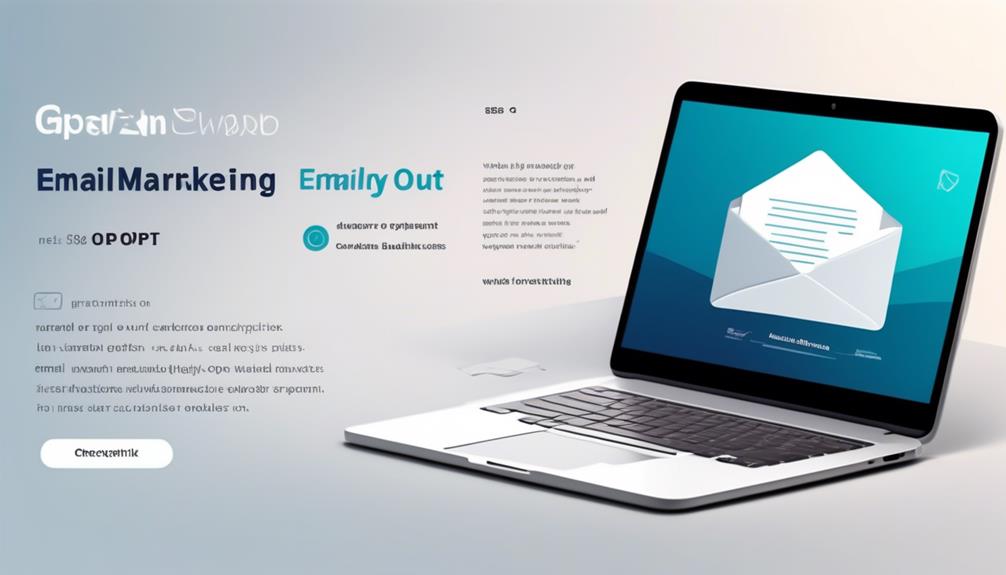
When ensuring GDPR compliance in email marketing, it's essential to obtain explicit consent from individuals before sending any marketing communications. Clearly stating the lawful purpose for collecting and using personal data in email marketing is crucial for compliance. Implementing a double opt-in process for subscribers to confirm consent adds transparency to your practices. Furthermore, providing easy and clear opt-out mechanisms in every marketing email is necessary to respect individuals' privacy rights.
Regularly auditing and cleaning mailing lists is essential to maintain GDPR compliance and build trust with customers. It ensures that data retention is in line with GDPR requirements and that only individuals who've given explicit consent receive marketing communications.
As email marketers, it's our responsibility to prioritize the security and privacy of EU citizens' data. By following these GDPR-compliant email practices, we demonstrate our commitment to data protection and build credibility with our audience. Compliance with GDPR not only safeguards individuals' privacy but also enhances the reputation and trustworthiness of our marketing efforts.
Double Opt-In Implementation
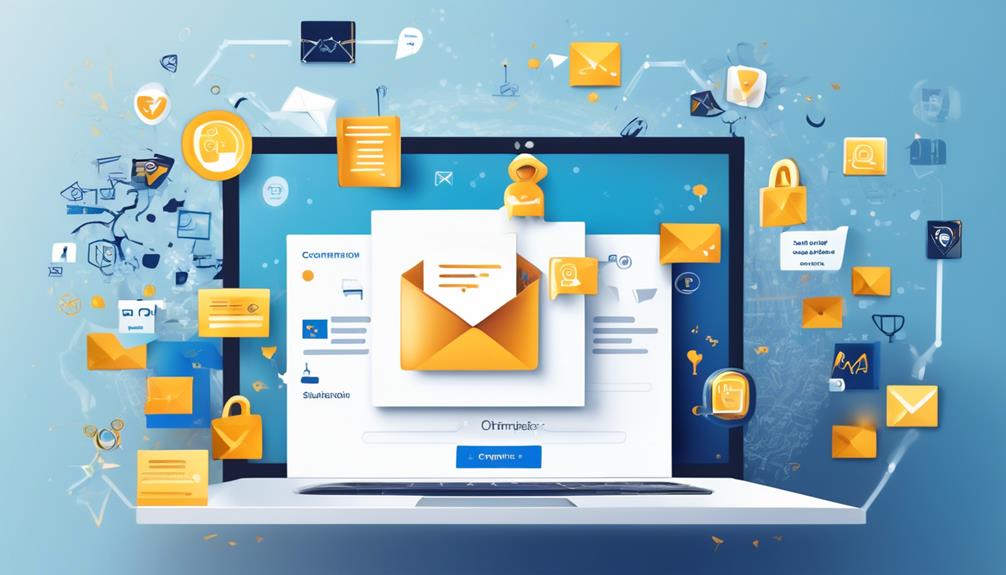
Transitioning from GDPR-compliant email practices, the implementation of Double Opt-In is a critical step for email marketers to enhance consent verification and reduce the risk of unauthorized sign-ups. Double Opt-In requires individuals to confirm their subscription twice, ensuring that they genuinely intend to subscribe and understand what they're signing up for.
Here's why it's crucial:
- Reduced Risk: By requiring a second confirmation, the risk of unauthorized sign-ups is significantly reduced.
- Consent Verification: Double Opt-In provides a clear audit trail of consent, essential for demonstrating GDPR compliance.
- Quality Improvement: Implementing Double Opt-In can enhance the quality of your email list, ensuring that your subscribers are genuinely interested in your content.
- Engagement Boost: It helps improve engagement levels as subscribers who've confirmed twice are more likely to be genuinely interested in your emails.
In the context of GDPR and data protection, Double Opt-In is an effective method for ensuring compliance with the regulation's consent and data retention requirements, ultimately protecting the personal data of EU data subjects.
Record-Keeping for Compliance

Maintaining meticulous records of consent is essential for demonstrating compliance with GDPR requirements for email marketing. As email marketers, we understand the significance of record-keeping in ensuring adherence to data protection regulations.
It's imperative to document the specific lawful basis for processing subscriber data for email marketing and to keep a record of how consent was obtained. This includes details of the opt-in method used, proof of consent, and any subsequent opt-out requests.
Regularly reviewing and updating these consent records is crucial to reflect any changes or withdrawals made by individuals, thereby ensuring that the stored information remains accurate and up to date.
Furthermore, it's essential to implement a robust system for capturing and securely storing consent information. This not only fulfills record-keeping obligations but also demonstrates a commitment to the security and privacy of subscriber data.
Clear and distinct consent from individuals for the processing of their personal data for email marketing purposes is a fundamental aspect of compliance. By maintaining comprehensive and secure records of consent, we can confidently comply with GDPR requirements and build trust with our subscribers.
Frequently Asked Questions
How Do I Comply With GDPR Email Marketing?
We comply with GDPR email marketing by obtaining clear consent, offering an easy opt-out, and ensuring all data collection is transparent.
It's crucial to interpret and follow GDPR rules carefully, providing proof of consent and keeping opt-out methods simple and free-of-charge.
Our compliance hinges on adhering to specific consent requirements and implementing opt-in processes.
It's imperative to understand and follow all GDPR regulations to ensure our email marketing practices are compliant.
What Is the GDPR Fine for Email Marketing?
The GDPR fine for email marketing can be substantial if organizations fail to comply with the strict regulations. It's crucial for email marketers to obtain clear consent from recipients and provide opt-out options.
Non-compliance may result in hefty penalties, as demonstrated by the €9 million fine imposed on Austrian Post.
Adhering to GDPR guidelines is essential for protecting both the organization and the privacy rights of individuals.
What Are the 7 GDPR Requirements?
We ensure GDPR compliance by meeting seven key requirements.
These include obtaining clear consent for data collection and email marketing, providing opt-out options, and maintaining proof of consent.
Our approach focuses on building trust with customers and engaging them while upholding legal standards.
These measures allow us to capture consent effectively and meet GDPR obligations.
What Are the GDPR Rules for Sending Emails?
We ensure GDPR compliance when sending emails by obtaining clear consent and providing opt-out options in every communication. Personal data is collected with explicit consent, and we maintain proof of consent for marketing purposes.
We remind individuals of their right to opt-out in each marketing message. These practices align with GDPR requirements for email marketing, allowing us to operate within legal boundaries and respect individuals' data privacy rights.
What Are the Essential GDPR Compliance Tips for Email Marketers?
Email marketers must adhere to the best practices for GDPR compliance in order to protect consumer data. Obtaining clear consent, maintaining an updated database, and providing opt-out options are crucial. Additionally, conducting regular audits and staying informed about GDPR regulations are essential for email marketers to remain compliant.
How Can GDPR Compliance Improve Email Open Rates in 2024?
In 2024, companies that prioritize GDPR compliance can expect to see a positive impact on their email open rate forecast. By ensuring that their emails are permission-based and provide valuable, relevant content, businesses can build trust with their audience and ultimately improve their email open rate forecast.
Conclusion
In conclusion, implementing GDPR compliance tips for email marketing is crucial for maintaining trust with our audience.
Did you know that 67% of consumers are more likely to engage with brands that prioritize their data privacy?
By following best practices, we can build stronger relationships with our subscribers and ensure that our email marketing efforts are both effective and compliant.
Natali – Editor in Chief (Strategy and Mastery, AI Expert) Natali, our Editor in Chief, is the driving force behind our content’s strategic direction. With a keen eye for detail and a deep understanding of market trends, Natali ensures that our content is top-notch and strategically aligned with our client’s goals. Her expertise in AI helps to seamlessly integrate advanced technology into our marketing strategies, pushing the boundaries of conventional marketing.
GDPR Email Marketing
5 Essential Tips for GDPR-Compliant Email Campaigns
Unlock the secrets to ensuring GDPR compliance and respecting subscriber privacy in your email campaigns with these essential tips.
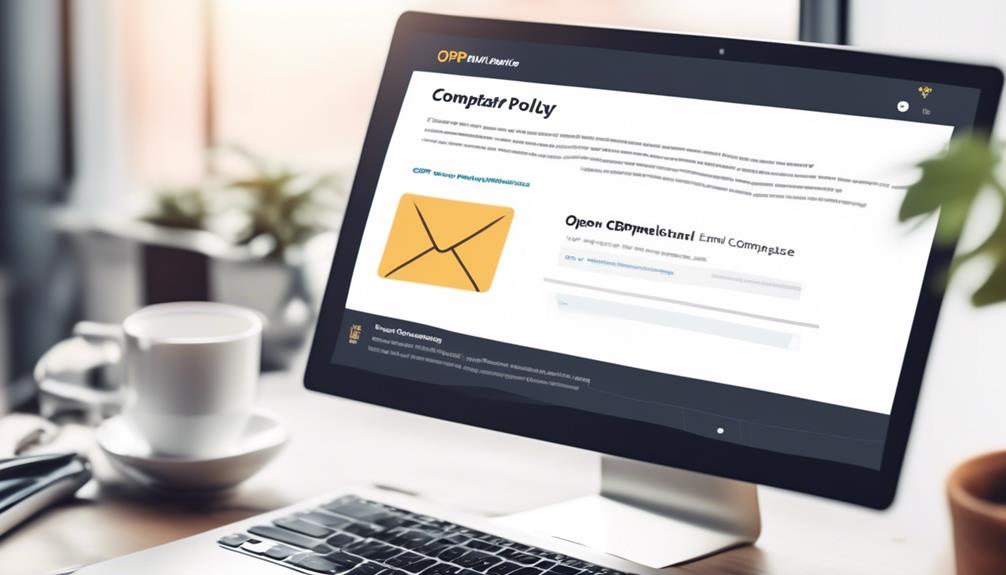
Chances are, you’re aware of the essential aspects to consider to make sure your email marketing strategies comply with GDPR standards. It goes beyond mere adherence; it’s about valuing the privacy and rights of your subscribers.
We all want to make sure we're doing things the right way, and in this fast-paced digital landscape, it's crucial to stay on top of best practices. Trust me, you don't want to miss out on these essential tips that could make or break your email campaigns.
Key Takeaways
- Obtain explicit and freely given consent from individuals for email marketing.
- Implement clear and unambiguous consent language and provide granular consent options.
- Regularly review and update security measures to ensure the protection of personal data.
- Respect subscriber preferences and honor opt-out requests promptly.
Key Principles of GDPR Compliance
Implementing the key principles of GDPR compliance ensures that our email campaigns prioritize transparency, data minimization, and security. Under the GDPR, consent for email marketing must be freely given, specific, informed, and obtained through affirmative actions. This means that individuals must actively opt in to receive marketing emails, and they should be fully aware of how their data will be used.
Transparency is crucial, requiring us to inform subscribers about the processing of their personal data for email marketing, including its use and storage. Data minimization is another vital principle, emphasizing the collection of only necessary data for marketing purposes.
When it comes to security, GDPR compliance necessitates implementing appropriate measures to protect the personal data of individuals. Additionally, accountability requires us to maintain records of data processing activities for email marketing.
It's important to remember that under GDPR, subscribers have the right to access, rectify, delete, object to, or restrict the processing of their personal data in email marketing. Adhering to these principles not only ensures compliance but also demonstrates our commitment to data protection and privacy.
Best Practices for Data Privacy

Building on the key principles of GDPR compliance, our approach to data privacy in email campaigns is anchored in ensuring clear and genuine consent while offering granular options for subscriber preferences.
When it comes to best practices for data privacy, we prioritize the following measures:
- Clear and Unambiguous Consent Language: We use language that's easily understandable and free from legal jargon when seeking consent from our subscribers. This ensures that they fully comprehend what they're agreeing to.
- Granular Consent Options: Our subscribers have the ability to select the specific types of emails they wish to receive. By providing granular consent options, we respect their preferences and promote a more personalized experience.
- Double Opt-In Confirmation Process: Implementing a double opt-in confirmation process helps us verify the authenticity of subscriber consent. This extra step ensures that the consent provided is genuine and reduces the risk of unintended opt-ins.
- Regular Security Measures Review: We regularly review and update our data protection measures to safeguard the personal data of our subscribers. This proactive approach aligns with GDPR regulations and demonstrates our commitment to maintaining GDPR-compliant email marketing practices.
Transparency and Accountability
To ensure compliance with GDPR regulations, we prioritize clear and concise communication regarding the use and storage of personal data in our email campaigns, maintaining transparency and accountability throughout our practices.
Transparency and accountability are key principles of GDPR, requiring the data controller to obtain explicit consent from individuals for the processing of personal data. Individuals have the right to know how their data is being used, and it's our responsibility to provide this information in a clear and understandable manner.
Additionally, we must respect data subject rights, including the rights to access, rectify, delete, object to, or restrict the processing of their personal data in our email marketing activities.
As part of our commitment to transparency and accountability, we keep detailed records of data processing activities and regularly review and update our security measures to safeguard personal data.
Upholding transparency and accountability in email campaigns not only ensures compliance with GDPR but also fosters trust and confidence among our subscribers regarding the handling of their personal information.
Opt-outs and Data Erasure Management

Prioritizing clear communication and robust data management processes is crucial for complying with GDPR regulations regarding opt-outs and data erasure in email campaigns. When managing opt-outs and data erasure, it's essential to adhere to GDPR guidelines and ensure the proper handling of personal data.
Here are some key considerations:
- Honor Opt-Out Requests: Respect individuals' rights by promptly processing and honoring opt-out requests. This involves providing a clear and accessible unsubscribe link in email communications.
- Implement Data Erasure Procedures: Develop and implement robust data erasure management processes to promptly delete personal data upon request. Regularly review and update these procedures to ensure compliance with GDPR requirements.
- Respect Consent: Ensure that individuals have given clear consent to receive marketing communications. Additionally, provide them with straightforward methods to manage their data preferences.
- Compliance with Right to Be Forgotten: As data controllers, it's crucial to respect individuals' right to be forgotten by promptly and effectively handling data erasure requests.
Role of Data Processors and Controllers
In understanding the GDPR compliance requirements, it is vital to recognize the distinct responsibilities of data processors and controllers. Data controllers determine the purposes and means of processing personal data, whereas data processors act on behalf of controllers, following documented instructions. Both entities are accountable for maintaining records of processing activities and implementing security measures to protect personal data. The table below provides a clear comparison of the responsibilities of data processors and controllers under GDPR.
| Responsibilities | Data Controllers | Data Processors |
|---|---|---|
| Compliance with GDPR | Responsible for ensuring processing activities comply with GDPR. | Must only act on documented instructions from the controller. |
| Data Protection | Accountable for implementing appropriate technical and organizational measures. | Required to assist controllers in meeting their obligations. |
| Record-Keeping | Responsible for maintaining records of processing activities. | Also required to maintain records of processing activities. |
| Cooperation | Essential for ensuring GDPR compliance and protecting individuals' rights regarding their personal data. | Essential for ensuring GDPR compliance and protecting individuals' rights regarding their personal data. |
Understanding the distinct roles and responsibilities of data processors and controllers is crucial for achieving GDPR compliance in email marketing and data collection activities. By clearly defining these roles, organizations can ensure that consent and processing activities align with GDPR requirements, ultimately enhancing data protection and compliance.
Frequently Asked Questions
How Do I Make My Email GDPR Compliant?
We make our email GDPR compliant by:
- Obtaining proper consent from recipients
- Ensuring transparent data collection
- Providing an easy opt-out option
We also:
- Regularly update our privacy policy
- Securely store data
- Only collect necessary information
Lastly:
- We stay informed about GDPR regulations
- Adjust our practices accordingly
These steps ensure that our email campaigns are compliant, build trust with our audience, and protect their privacy.
What Practice Should an Email Campaign Follow to Comply With Gdpr?
We should obtain explicit consent from individuals before collecting and processing their personal data.
We should provide clear information about data use and storage.
We should implement a double opt-in confirmation process.
We should regularly review and update security measures.
We should integrate privacy considerations into every stage of the email marketing process.
This ensures GDPR compliance and respects subscribers' rights to their personal data.
What Are the 7 GDPR Requirements?
We understand the 7 GDPR requirements as follows:
- Consent should be freely given, specific, informed, and obtained through affirmative actions.
- Transparency and accountability are emphasized.
- The right to be forgotten allows individuals to request data deletion.
- Businesses must maintain records and implement security measures.
- GDPR includes principles like lawfulness, fairness, and transparency, purpose limitation, data minimization, accuracy, storage limitation, integrity, confidentiality, and accountability.
These requirements form the foundation for GDPR compliance.
What Are the GDPR Rules for Sending Emails?
We need to ensure GDPR compliance when sending emails. Consent must be explicit and informed, with clear communication on data use and security measures implemented.
Individuals have the right to request data deletion, and best practices include clear consent language and a double opt-in process.
Non-compliance can lead to severe consequences.
How Can Email Marketers Ensure GDPR Compliance in Their Campaigns?
When it comes to email marketing, ensuring GDPR compliance is crucial. Some key GDPR compliance tips include obtaining explicit consent from subscribers, providing easy opt-out options, and securing data through encryption and secure storage. Email marketers must also regularly review and update their privacy policies to stay compliant.
Conclusion
In conclusion, GDPR compliance is essential for successful email campaigns. By obtaining explicit consent, informing subscribers about data use, and implementing strong security measures, we can build trust and credibility with our audience.
For example, a company saw a 20% increase in email open rates after implementing GDPR-compliant practices, showing that respecting data privacy rights can lead to improved engagement and results.
Natali – Editor in Chief (Strategy and Mastery, AI Expert) Natali, our Editor in Chief, is the driving force behind our content’s strategic direction. With a keen eye for detail and a deep understanding of market trends, Natali ensures that our content is top-notch and strategically aligned with our client’s goals. Her expertise in AI helps to seamlessly integrate advanced technology into our marketing strategies, pushing the boundaries of conventional marketing.
GDPR Email Marketing
GDPR Email Marketing: Consent Examples Guide
Uncover practical examples and guidelines for GDPR consent in email marketing, ensuring transparent and unambiguous subscriber requests. Curious to see how it's done?
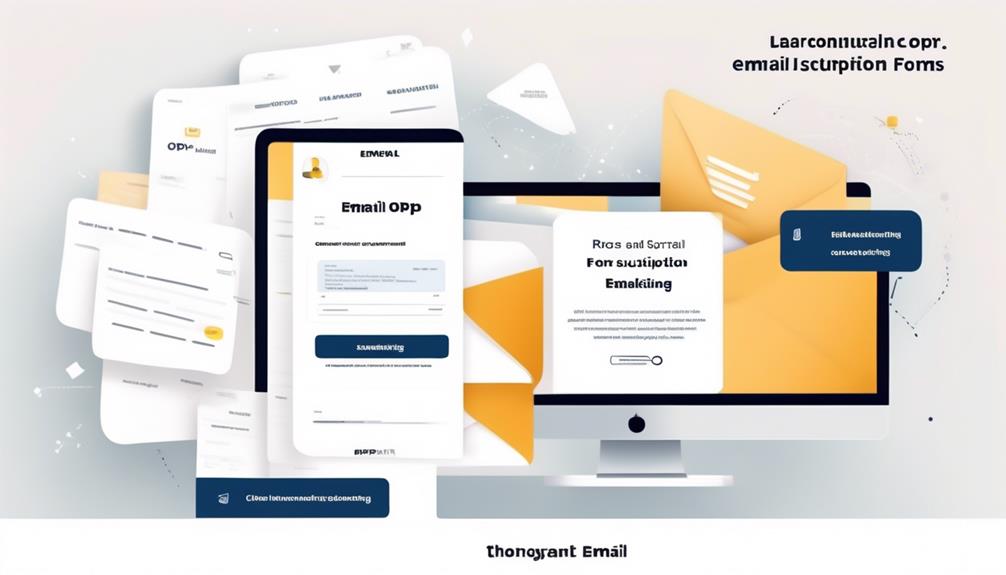
All of us have found ourselves in circumstances where we get an unexpected email, leaving us puzzled about how our contact details were acquired to begin with. It feels similar to discovering a promotional flyer for a novel eatery in your mailbox, despite never showing any inclination towards eating out.
As email marketers, we understand the importance of gaining consent from our subscribers before bombarding them with promotional content. However, navigating the intricacies of GDPR compliance in email marketing can be a daunting task.
How can we ensure that our consent requests are transparent and unambiguous? Let's explore some practical examples and guidelines to steer us in the right direction.
Key Takeaways
- Use clear and straightforward language in consent forms to build credibility and trust with the audience.
- Avoid pre-ticked checkboxes and ensure that users actively select unticked checkboxes to give consent.
- Emphasize the separation of consent and legal policies to maintain compliance with regulations.
- Use clear and easily understandable language in consent terms, avoiding ambiguity and using clear affirmative phrases.
Transparent Consent Requests
Transparent consent requests are an integral part of GDPR compliance and involve using clear, straightforward language to explain the purpose of consent and how the data will be used. When obtaining consent for email marketing or any data processing activities, it's crucial to ensure that the language used in consent forms is easily understandable.
Clearly naming your organization and disclosing any third parties involved is essential. This transparency instills trust and demonstrates respect for the user's data privacy. Avoiding complex phrasing and being transparent about the purpose of data collection and usage are key aspects of transparent consent requests.
It's important to clearly explain why the data is needed and what'll be done with it, ensuring users have a clear understanding before providing consent. By doing so, organizations not only adhere to GDPR requirements but also build credibility and trust with their audience.
Ultimately, transparent consent requests play a pivotal role in fostering positive relationships with users and demonstrating a commitment to ethical and lawful data processing practices.
Avoid Pre-Ticked Checkboxes
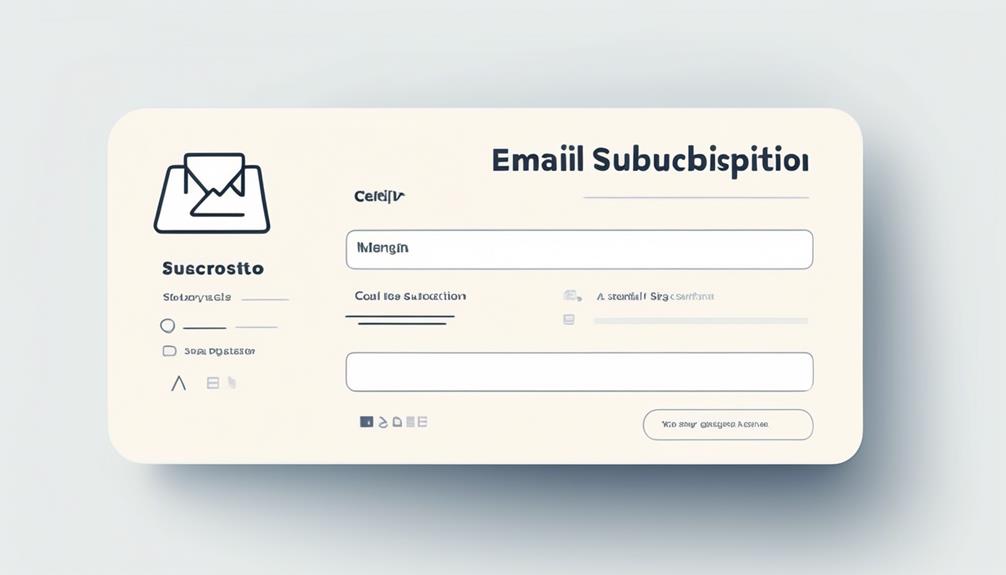
We must ensure that our consent forms don't use pre-ticked checkboxes to comply with GDPR requirements. Using pre-ticked checkboxes isn't allowed under GDPR consent requirements, as consent must be freely given.
To ensure compliance and transparency, here are three key considerations for GDPR consent forms:
- Active Opt-In: Users should be required to actively select unticked checkboxes to give consent. This ensures that consent is freely given and unambiguous, meeting the lawful basis for processing under GDPR.
- Avoid Implied Consent: It's important to avoid using pre-ticked checkboxes, implied consent, or default consent methods. Users must take a positive action to provide clear and unambiguous consent.
- Right to Withdraw Consent: Consent examples should clearly convey to users their right to withdraw their consent at any time. Providing clear instructions on how to withdraw consent reinforces transparency and empowers users to manage their consent preferences.
Separate Consent and Legal Policies
When providing examples and guidance for GDPR email marketing consent, it's crucial to emphasize the importance of separate consent and legal policies.
This involves ensuring clear consent terms, using unambiguous language, and maintaining compliance with regulations.
Clear Consent Terms
To ensure clarity and transparency, it's essential to separate consent requests from legal terms and conditions in email marketing communications. When crafting clear consent terms, it's important to use language that's easily understandable and avoids ambiguity. To achieve this, consider using clear affirmative phrases that leave no room for misinterpretation.
Additionally, ensure that your consent forms are straightforward and prominently displayed, with no pre-ticked checkboxes. Furthermore, provide easy access to your privacy policies and clearly outline the process for users to withdraw consent if they choose to do so.
Unambiguous Language Use
As we move on to 'Unambiguous Language Use', it's crucial to distinctly separate consent requests from legal terms and conditions in email marketing communications.
To ensure GDPR compliance, it's essential to use clear and unambiguous language when seeking consent from individuals. When crafting consent requests, it's important to avoid combining them with other matters, such as terms of service or privacy policies. By keeping consent requests separate from legal jargon, recipients can better understand the nature of the consent being sought.
This approach also aligns with GDPR's requirement for specific and informed consent for separate things. Therefore, in our processing operations, we must be diligent in using unambiguous language to clearly present consent requests without intertwining them with legal policies.
This not only demonstrates our commitment to GDPR compliance but also enhances transparency and trust in our email marketing practices.
Compliance With Regulations
Compliance with GDPR regulations requires clear separation of consent requests from legal terms and conditions in email marketing communications. To ensure that your email marketing efforts are GDPR compliant, the following steps should be taken:
- Separate Consent Requests: Consent must be clearly distinguishable from legal policies to ensure compliance with GDPR.
- Enable Right to Withdraw: Users should have the right to withdraw their consent at any time, as per GDPR requirements.
- Proof of Consent: Maintain records to demonstrate that valid consent has been obtained, including details of what the individual has consented to and when and how this consent was obtained.
Granular Consent Options
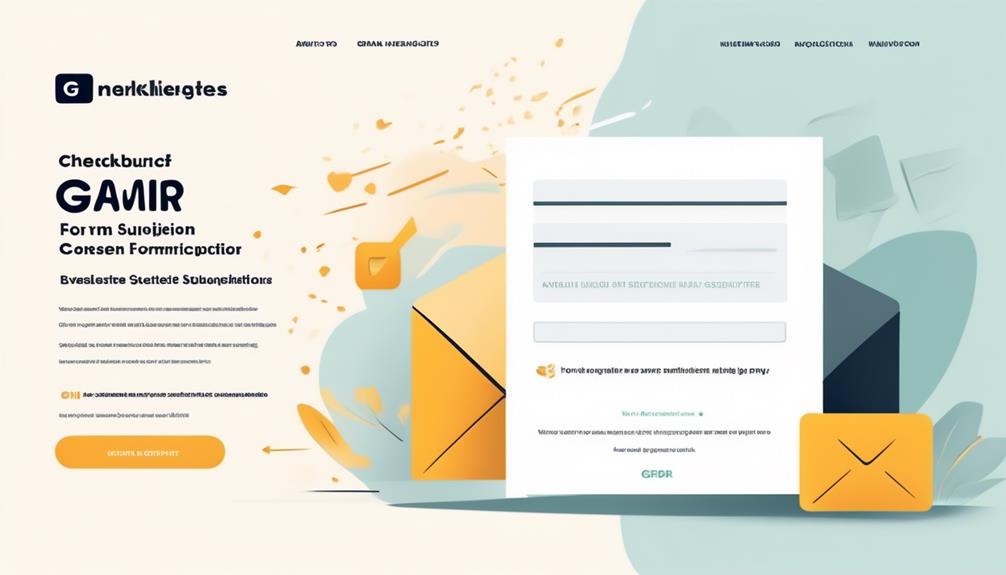
Granular consent options in email marketing allow individuals to provide specific consent for different types of data processing activities. This empowers them to make informed decisions about how their data is utilized.
This approach provides users with the ability to choose consent preferences for various marketing communications separately, including email, SMS, or postal communication. By offering clear and detailed consent choices, organizations ensure transparency and control over individuals' personal data, crucial for GDPR compliance.
With granular consent options, users can opt-in or opt-out of specific types of data usage, aligning with the GDPR's emphasis on empowering individuals to exercise control over their personal data.
This level of control not only benefits users but also helps organizations build trust and demonstrate their commitment to data privacy. Granular consent options are an essential aspect of GDPR compliance, as they enable organizations to respect users' preferences and provide them with meaningful choices regarding the processing of their personal data.
Easy Withdrawal of Consent

Ensuring individuals can effortlessly revoke their consent for data processing is a fundamental tenet of GDPR compliance and essential for maintaining trust and transparency in email marketing practices. GDPR requires that individuals have the right to withdraw their consent at any time, and as such, email marketers must facilitate easy withdrawal of consent.
Here are key strategies to achieve this:
- Separate Consent: Obtain separate consent for different types of processing activities, ensuring that individuals can revoke consent for specific purposes without affecting other consents.
- Double Opt-in: Implement a double opt-in process, where individuals confirm their consent twice before being added to a mailing list. This not only ensures explicit consent but also provides a clear path for withdrawal.
- Unsubscribe Link: Include a prominent and easily accessible unsubscribe link in all marketing emails. This allows individuals to withdraw their consent effortlessly, without encountering barriers or delays.
Recordkeeping for Consent
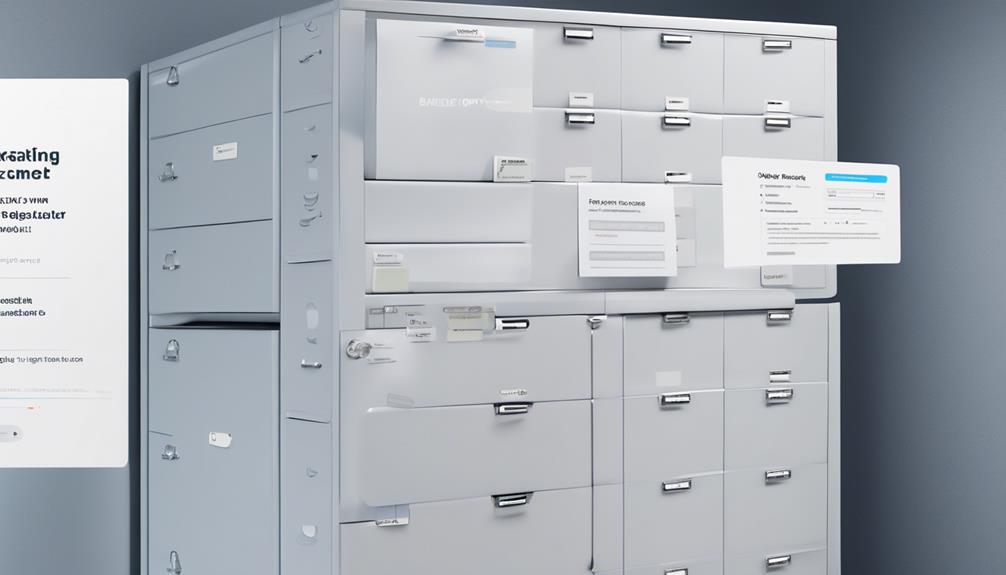
Maintaining trust and transparency in email marketing practices, we must adhere to GDPR's requirement for recordkeeping of consent choices, including the method and timing of individuals' consent, as we move into the subtopic of 'Recordkeeping for Consent'.
Recordkeeping for consent is a crucial aspect of GDPR compliance in email marketing. It involves maintaining detailed records of how and when individuals provided consent, what they were informed about at the time of consent, and the specific method used for obtaining their consent, such as through an opt-in form or another explicit action.
These records are essential for demonstrating compliance with GDPR requirements and for providing evidence in case of any disputes or regulatory inquiries. Effective recordkeeping ensures that organizations can prove they obtained valid consent from individuals and that they've respected individuals' choices regarding their personal data.
Additionally, maintaining accurate consent records enables organizations to promptly honor requests for withdrawal of consent, as required by GDPR.
Information to Record for Consent
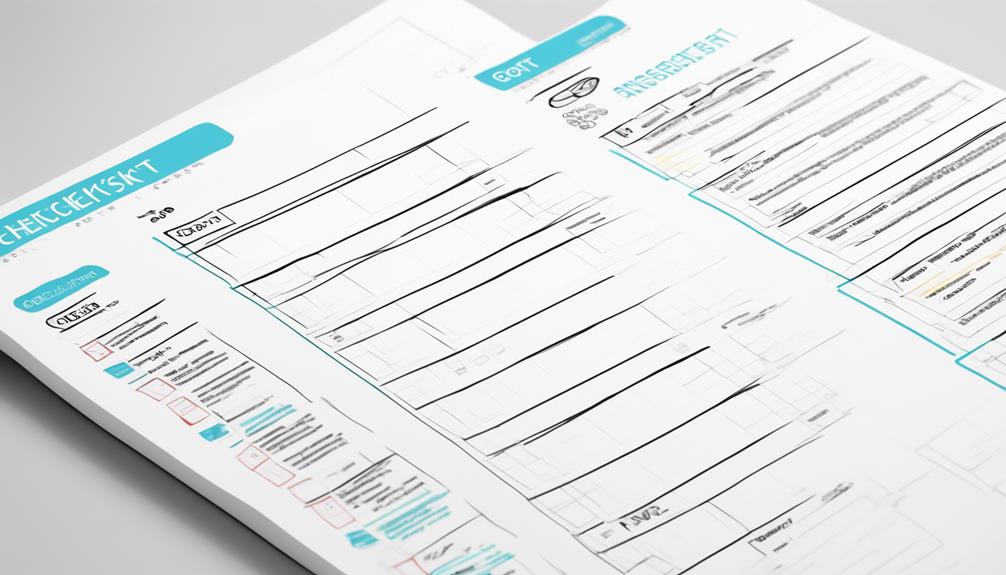
To ensure comprehensive compliance with GDPR requirements, it's crucial to accurately record specific details when obtaining consent for email marketing purposes. When recording consent for GDPR email marketing, the following information should be carefully documented:
- Date and Time: Record the exact date and time when consent was given, as this is crucial for demonstrating compliance with GDPR requirements and for potential future audits.
- Method of Consent: Document the method through which consent was obtained, whether it was through an online form, verbal agreement, or any other means. This ensures transparency and accountability in the consent process.
- Purpose and Use of Data: Specify the purpose for which consent is given and how the data will be used. This includes providing clear information on the intended use of the data and the specific marketing activities it relates to.
It's important to note that relying on pre-ticked checkboxes or implied consent isn't considered valid under GDPR. Seek legal advice to ensure that the information recorded for consent aligns with the legal requirements and best practices for GDPR email marketing compliance.
User Consent Management
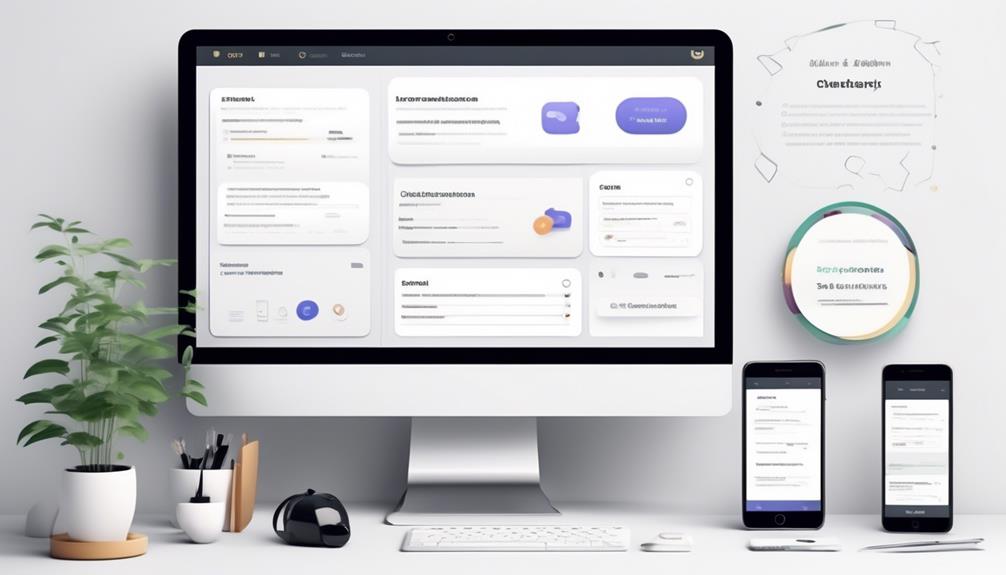
Now, let's address the crucial aspects of user consent management.
We'll explore the optimal opt-in consent process, the importance of providing consent withdrawal options, and the necessity of data retention compliance.
These points are fundamental for ensuring that our email marketing practices align with GDPR regulations and respect user privacy.
Opt-In Consent Process
Implementing an effective opt-in consent process is crucial for ensuring compliance with GDPR regulations on user consent management. To achieve this, we need to:
- Obtain specific, informed, and unambiguous consent from individuals, allowing them the right to easily withdraw consent. This ensures that individuals are fully aware of the privacy implications of their consent.
- Consider implementing a double opt-in consent request for mailing lists, although it isn't explicitly required by GDPR, to ensure a robust verification process.
- Provide users with a way to manage their consent choices, including the ability to change their minds at any time, as required by the General Data Protection Regulation.
Consent Withdrawal Options
Ensuring that users have straightforward and accessible options to withdraw their consent is a fundamental aspect of GDPR compliance and user consent management. Providing clear and easy-to-use consent withdrawal options is essential for respecting users' rights under GDPR. Users must have the ability to change their consent preferences at any time, as the basis for processing data relies on their freely given consent. To facilitate this, websites should offer consent preference centers and Data Subject Access Request (DSAR) forms that are easily accessible. Below is a table outlining some common consent withdrawal options:
| Consent Withdrawal Options | Description |
|---|---|
| Preference Center | Online platform for users to manage their consent choices |
| DSAR Form | Form for users to request access to and control over their personal data |
| Soft Opt-In | Allowing users to opt out of consent easily, even after initially giving consent |
Data Retention Compliance
Data retention compliance is a critical aspect of user consent management under GDPR, requiring organizations to carefully oversee and document user consent throughout the data lifecycle. To ensure compliance, organizations should:
- Record and store consent data, including details of when, how, and what users consented to, as part of their privacy policy.
- Enable users to easily withdraw their consent, in accordance with GDPR requirements, by providing clear and accessible withdrawal options.
- Consider implementing a double opt-in process for obtaining and managing user consent for mailing lists, and explore alternative methods for obtaining unambiguous consent, such as using pop-ups, based on applicable laws and proper notice to users.
Effective data retention compliance is essential for organizations to align their practices with GDPR and ensure the lawful processing of personal data.
GDPR Compliant Opt-in Examples
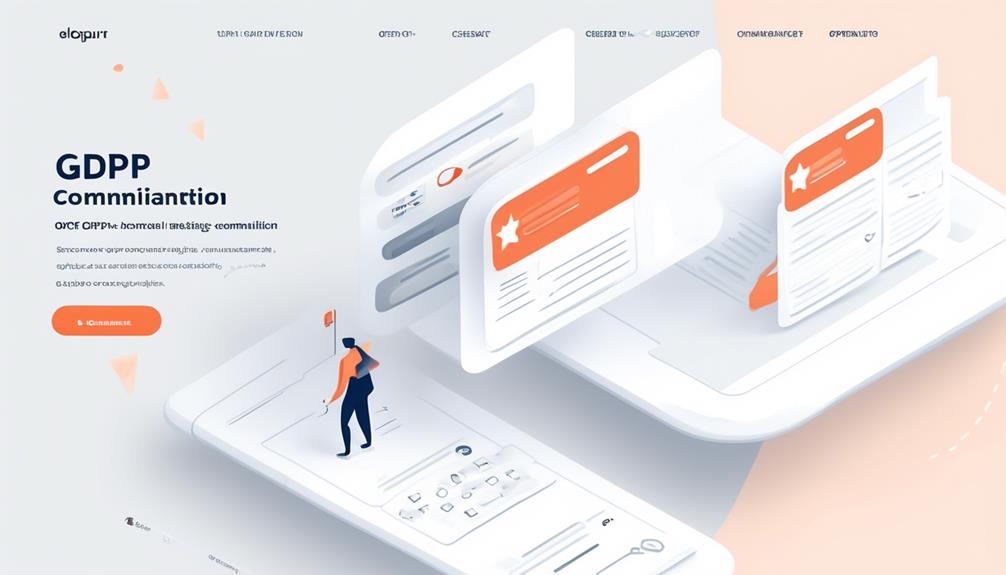
When seeking GDPR-compliant opt-in examples for email marketing, it's crucial to ensure that consent is specific, informed, and unambiguous, in line with GDPR regulations.
One effective example of GDPR-compliant opt-in consent involves using clear, unambiguous language to explain to users that by providing their email address, they're consenting to receive marketing communications. This explanation should also outline how their personal data will be used, emphasizing transparency.
Additionally, it's important to avoid pre-ticked checkboxes or any form of implied consent, as these practices don't align with GDPR requirements.
Implementing a double opt-in process for mailing lists can also serve as a best practice, although it isn't explicitly mandated by GDPR. This process involves sending a confirmation email to the user after they initially opt-in, requiring them to take a further action to confirm their subscription.
It's also crucial to provide users with a simple way to withdraw their consent, as per GDPR guidelines, ensuring that they can easily opt out of receiving marketing communications.
Opt-in Form Examples
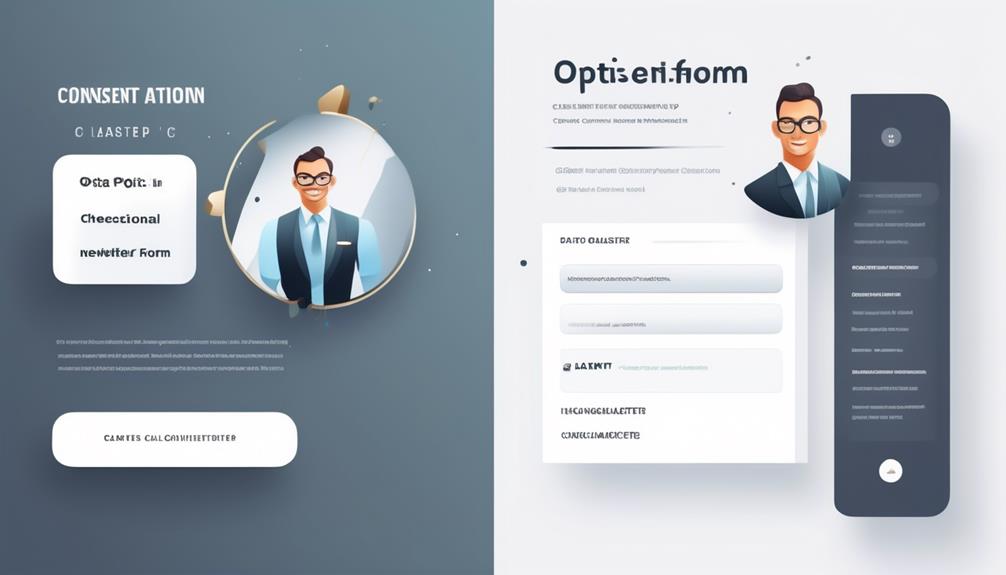
To enhance user understanding and compliance with GDPR regulations, opt-in form examples should utilize clear and straightforward language to request consent. When creating opt-in forms for email marketing, it's crucial to follow GDPR guidelines and best practices. Here are three key elements to consider when designing opt-in forms:
- Clear and Unambiguous Language: Opt-in forms should use language that's easy to understand and free from ambiguity. Clearly state what the user is consenting to, such as receiving marketing emails or sharing their data with third parties.
- Unticked Checkboxes: Avoid using pre-ticked checkboxes, implied consent, or default consent. Instead, present users with unticked checkboxes that they must actively select to give consent. This ensures that consent is explicit and affirmative.
- Double Opt-In Consent: Consider implementing a double opt-in process for mailing lists. After users fill out the online consent form, they should be required to confirm their email address to verify their consent.
Effective Permission Reminders
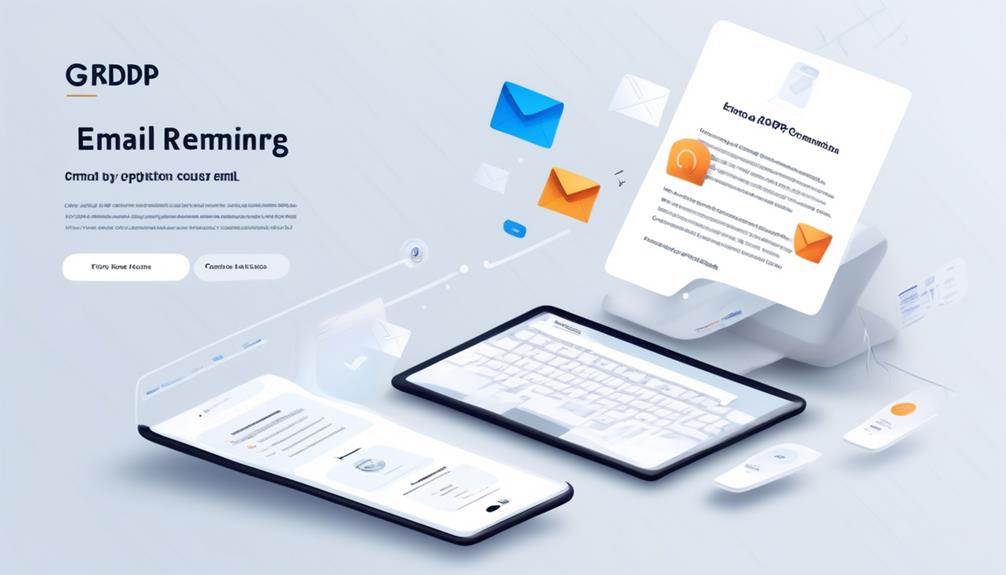
As we shift our focus to 'Effective Permission Reminders', it's essential to maintain clarity and transparency in our communication with users regarding their consent for email marketing. Effective permission reminders should clearly explain why the data is being collected and how it will be used to maintain transparency with users. Utilize clear and specific language to request consent, avoiding pre-ticked checkboxes or vague statements to ensure understanding and meet GDPR requirements. Consider implementing double opt-in consent for mailing lists as a best practice, even though it is not explicitly required by GDPR, to verify and record user consent. Provide users with easy ways to manage their consent choices, including the ability to withdraw consent and access a consent preference center on the website, as required by GDPR. Below is a table summarizing the key points for creating effective permission reminders in GDPR email marketing.
| Key Points | Description |
|---|---|
| Clearly Explain Data Collection and Use | Explain why the data is being collected and how it will be used to maintain transparency with users. |
| Utilize Clear and Specific Language for Consent | Avoid pre-ticked checkboxes or vague statements to ensure understanding and meet GDPR requirements. |
| Provide Easy Consent Management Options | Offer users easy ways to manage their consent choices, including the ability to withdraw consent and access a consent preference center on the website. |
GDPR Compliant Email Marketing Examples
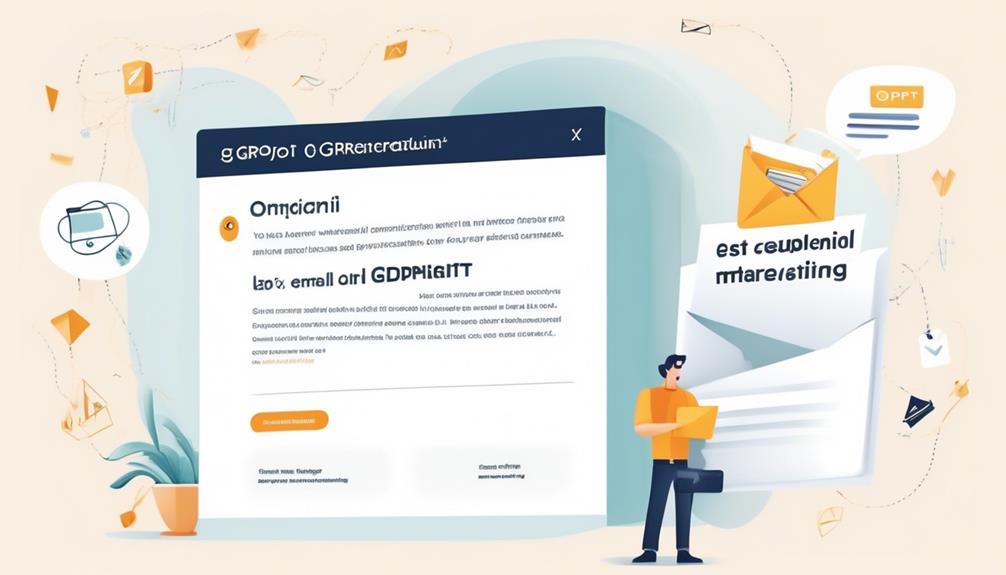
In our pursuit of GDPR compliance in email marketing, we exemplify best practices through clear and explicit consent procedures that prioritize user understanding and choice.
When implementing GDPR compliant email marketing, we ensure that consent is freely given, specific, informed, and unambiguous. We avoid non-compliant checkbox usage, such as pre-ticked checkboxes and implied consent, as they violate GDPR.
Additionally, we consider implementing a double opt-in consent request for mailing lists, although it's not explicitly required by GDPR. We also provide alternative methods for unambiguous consent, such as pop-ups asking users to enter their email address with clear phrases and labeled buttons.
Furthermore, we prioritize making it easy for users to withdraw consent, and we maintain a record of consent choices, including when, how, and what users consented to, in accordance with GDPR requirements.
Frequently Asked Questions
How Do I Write a GDPR Consent Form?
We write GDPR consent forms by ensuring they're freely given, specific, informed, and unambiguous, as required by GDPR.
We avoid pre-ticked checkboxes and use clear, easy-to-understand language in consent requests.
Consider implementing a double opt-in consent request for mailing lists and provide alternative methods for obtaining unambiguous consent.
Allow users to easily manage their consent choices and provide a way for them to withdraw consent, as per GDPR requirements.
How Do I Comply With GDPR Email Marketing?
We comply with GDPR email marketing by obtaining freely given, specific, informed, and unambiguous consent. We avoid non-compliant checkbox usage, implement double opt-in consent when possible, and utilize alternative methods for unambiguous consent, such as clear pop-ups and labeled buttons.
We also provide users with the ability to manage their consent choices and easily withdraw consent. These practices ensure compliance with GDPR requirements for email marketing.
What Is GDPR Compliant Consent Wording?
We ensure GDPR compliant consent by using clear, specific, and unambiguous language in our consent requests. We identify ourselves and disclose any third parties involved.
To avoid non-compliant checkbox usage, we require users to actively select unticked checkboxes for consent. For mailing lists, we implement double opt-in consent requests, where users confirm their email address.
Alternative methods like pop-ups with clear phrases and labeled buttons also comply with GDPR.
What Is an Example of Consent Email?
Sure!
An example of a consent email would be one that clearly outlines what data is being collected and how it will be used. It provides an option to easily withdraw consent and uses explicit language for permission.
It's important to avoid pre-ticked checkboxes or implied consent. Double opt-in requests are a best practice. Using clear phrases and labeled buttons can also help ensure unambiguous consent.
Can You Provide Examples of GDPR-Compliant Email Marketing Consent?
Yes, I can provide examples of GDPR-compliant email marketing consent. One example is clearly outlining how the subscriber’s data will be used and obtaining explicit gdpr consent for email marketing. Another example is providing a clear and easy opt-in process for subscribers to give their consent for email marketing under GDPR regulations.
Conclusion
In conclusion, ensuring GDPR compliance in email marketing is crucial for protecting the privacy and rights of subscribers. By implementing transparent consent requests, granular options, and easy withdrawal processes, email service providers can help users maintain compliance.
Let's strive to avoid pre-ticked checkboxes and provide effective permission reminders to create a harmonious and respectful email marketing environment.
Together, we can navigate GDPR requirements and build trust with our subscribers, like a well-choreographed dance.
Natali – Editor in Chief (Strategy and Mastery, AI Expert) Natali, our Editor in Chief, is the driving force behind our content’s strategic direction. With a keen eye for detail and a deep understanding of market trends, Natali ensures that our content is top-notch and strategically aligned with our client’s goals. Her expertise in AI helps to seamlessly integrate advanced technology into our marketing strategies, pushing the boundaries of conventional marketing.
-

 Email Automation1 month ago
Email Automation1 month agoAutomated Email Marketing 101: A Beginner's Tutorial
-

 Email Warmup1 month ago
Email Warmup1 month agoWarm Follow-Up Email
-

 Email Design Hub2 months ago
Email Design Hub2 months ago3 Essential Tools for Email Marketing Design Success
-

 Email Marketing1 month ago
Email Marketing1 month agoWhat Is Email Marketing Advantages and Disadvantages
-

 Email Marketing1 month ago
Email Marketing1 month agoWhy Email Marketing Is Effective
-

 Email Template1 month ago
Email Template1 month agoCrafting the Perfect Book Club Invitation Email Template
-

 Search Engine Optimization1 month ago
Search Engine Optimization1 month agoSEO Checklist: Enhance Your Site’s Performance
-

 Email Marketing1 month ago
Email Marketing1 month agoDoes Email Marketing Work in 2024





















